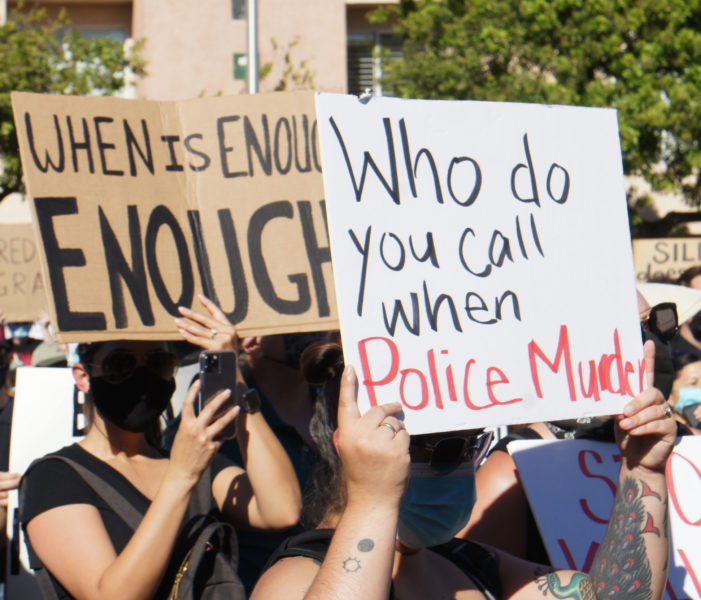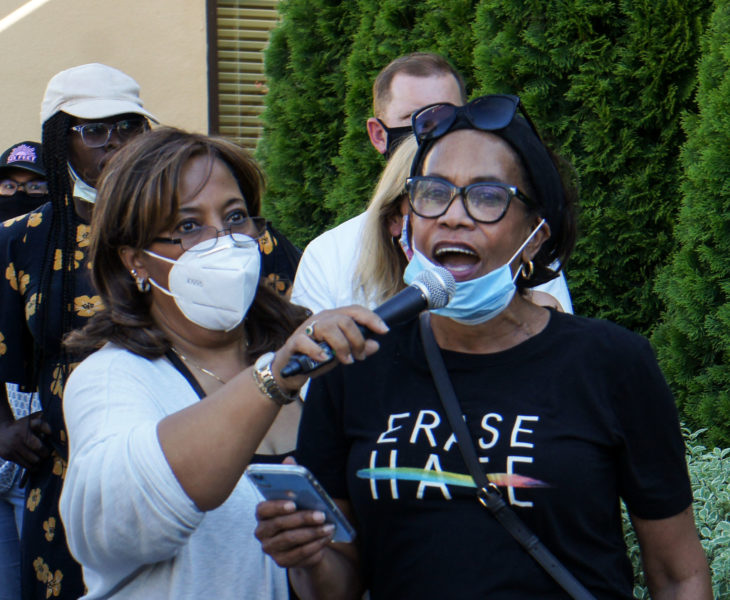
Aragon student Sabine Milton speaking at the protest.

On May 25, Minneapolis resident George Floyd was killed during an altercation with police officers. His death ignited outrage around the globe, fueling Black Lives Matter movements, a campaign founded in 2013 following a similar case of police brutality directed at black Americans. Amidst protests around the globe following Floyd’s death, local youth activists organized a protest in San Mateo to show solidarity for the movement.
The peaceful protest on June 3 was organized by Coalition Z San Mateo, a chapter of a national group that was founded in January by student activists.
“[Coalition Z’s] message is to bridge the gap between Gen[eration] Z and the government because we feel, especially today, sometimes our voices are silenced,” said Coalition Z Vice President Alexandra Iliopoulou.
The protest was publicized online and via social media for 5 p.m., starting at San Mateo City Hall and ending at the San Mateo Police Department.
“City Hall is symbolic of the legislative process, and it’s representative of the people and their representation [in government],” Iliopoulou said. “Marching to the police [department] was more to signify police brutality, and how we’re protesting the awful incidents that happened to innocent black people.”
Leading up to the protest, Coalition Z was in contact with the SMPD in an attempt to ensure the safety of protesters and community members. On June 2, the SMPD hosted a virtual town hall with a panel of nine speakers to discuss how the current justice system operates in San Mateo and how the SMPD can better their practices.
“I can say that, not only as a president of the NAACP branch, as an assistant pastor of a church, but as a mother, I’m scared. I’m scared every time my boys leave the house,” said San Mateo NAACP President Rev. Lorrie Owens at the town hall. “I’m scared that they are going to encounter a situation … where they may run into that one or two or three bad cops, where they will end up in a situation where at best, they may be racially profiled and at worst, they could end up dead.”
Owens was also one of several speakers who addressed the crowd in the City Hall parking lot, which spilled into the surrounding street. Other speakers included Coalition Z leadership, a member of the San Mateo Foster City School District Board, local activists, the first black mayor of San Mateo, and Rep. Jackie Speier. Organizers made a conscious effort to feature the voices of black community members.
“I hope that people took away from my speech just how personal this movement is to some people,” said rising Aragon senior Sabine Milton, a speaker at the event. “I wanted to remind people that sure we’re here for Black Lives Matter but we’re here to support George Floyd but we’re also here to make changes within our own community.”

The presence of officers at the march was not minor, as intersections and entire streets surrounding City Hall were blocked off by cop cars. While organizers did face some backlash for including the police department in the planning of the protest, they felt a conversation with police was necessary to ensure the safety of protestors.
“The protest isn’t just against the San Mateo police department. It’s against the entire [justice] system,” said Coalition Z President Sophia Heath. “While we are protesting police brutality, we need to prioritize the safety of our protesters.”
This precaution may have been deemed necessary due to the explosive nature of many similar protests occurring across the nation simultaneously. At the same time that San Mateo’s protest was happening, a protest in the Mission District of San Francisco had attracted the attention of the National Guard and tanks were stationed throughout the city. In other cities, peaceful protests had devolved into violence, looting and riots. The Associated Press estimated that by June 4, arrests at protests related to Floyd’s death and the Black Lives Matter movement had reached 10,000.
Organizers and protesters hope this demonstration will help start conversations for lasting change in the current justice system. On June 5 San Mateo Mayor Joe Goethals met with Barberini to discuss ways to adjust the justice system in the future.
“In the coming weeks and months, we will be announcing specific policies and reforms that we hope will keep police officers and the public safe,” Goethals said the day after the protest.

Milton hopes that people will use the current tragedies as an opportunity to educate themselves about the legacy of racism in America, and how it affects the daily lives of black citizens.
“I think that the whole new ethnic [studies] class for freshmen is a good way to start,” Milton said. “A lot of the time, people are racist just because they’re not educated about people of colors’ history, minority history … but I also feel that [the class] probably shouldn’t just be limited to freshmen.”
Other speakers emphasized the need for everyone to recognize the roles that systematic racism play in institutions like policing, criminal justice and education, and to take steps to reform them.
As protests continue to be held across the U.S., many community leaders pushing a reform plan called “8 Can’t Wait,” which outlines eight policies for local governments to enact that would minimize police brutality. San Mateo has already instituted two of these policies, duty to intervene and requirement to warn before shooting, and community members have been asking for the remaining six to be implemented. San Mateo Mayor Joe Goethals said, in an interview, that the other six use of force policies are not inconsistent with San Mateo’s policies, just not explicit, and he will be working with San Mateo Chief of Police Ed Barberini to see what, if anything, prevents them from explicitly adopting the “8 Can’t Wait” use of force policies.
Reporting by Kayla Shiao and Josette Thornhill



